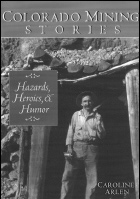|
written by
Amy Maestas
 It
has been nearly 20 years now since the big bust of the
mining boom in the San Juan Mountains. Since then, the
dearth of mining jobs has put a new face on Western towns
built up by a once-flourishing commerce. Most mines have
dried up. Gone with them is a generations-long subculture
of miners who have all the stories. It
has been nearly 20 years now since the big bust of the
mining boom in the San Juan Mountains. Since then, the
dearth of mining jobs has put a new face on Western towns
built up by a once-flourishing commerce. Most mines have
dried up. Gone with them is a generations-long subculture
of miners who have all the stories.
But in Caroline Arlen’s new book, Colorado Mining
Stories: Hazards, Heroics & Humor, that lost subculture
lives again. In it, readers are treated to an insightful
romp through mining history as told by surviving miners
or their kin.
Arlen, a Durango writer, digs up more than two dozen regional
people who tell stories of their hardrock mining heydays.
With Arlen’s skillful editing and talent for picking
out the gems, the character of each miner comes alive.
There are themes that pervade the book – barroom
brawls, tragedies narrowly averted, pain and laughter
– but each person spins his or her yarn differently
enough to weave an individual treasure. These miners are
colorful, politically incorrect, curmudgeons, and funny.
Together, Arlen and the miners recreate a sense of camaraderie
and expose the unfamiliar concept of choosing a job out
of necessity instead of choice.
For many of these miners – women included –
a job in the mines was their only ticket to survival.
They were inured to the risks and dangers of mining and
the hardships of a fickle industry, but they forged ahead
with high spirits and humility into an underground world
that many don’t know exists. These people worked
hard – and they lived hard. Younger readers (40
and under) will be exposed to an old-fashioned work ethic
that some lament the death of – putting in an honest
day’s work, pledging decades of loyalty to one company
and not complaining about mistreatment or lack of recognition.
It’s obvious that miners were – and, though
dwindling in numbers, are – a different species
from other blue-collar workers. They watched out for each
other like they did their own families, and their community
was as strong and solid as the rock they excavated. This
is what carried them through some of the roughest decades
from 1870 and on. Though women were rare fixtures in those
harsh mountains, they contributed mightily and earned
their place.
This book also is important for its historical contributions
(Arlen includes a glossary of mining terms), but it is
not dreary textbook history. Each story is the cut and
thrust, the kick and kiss of what hardrock mining contributed
to this country’s history and economy. By tracking
down these storytellers, Arlen hits a vein of gold –
something every one of these miners hoped to do themselves
as they charged day in and day out into the deep, dark
dampness. Unlike some gold diggers, readers won’t
catch Arlen high-grading the emotions and drama of this
group of unpretentious history makers. This book is genuine,
tender and rough. Pour yourself a glass of whiskey and
settle in with it.
|

